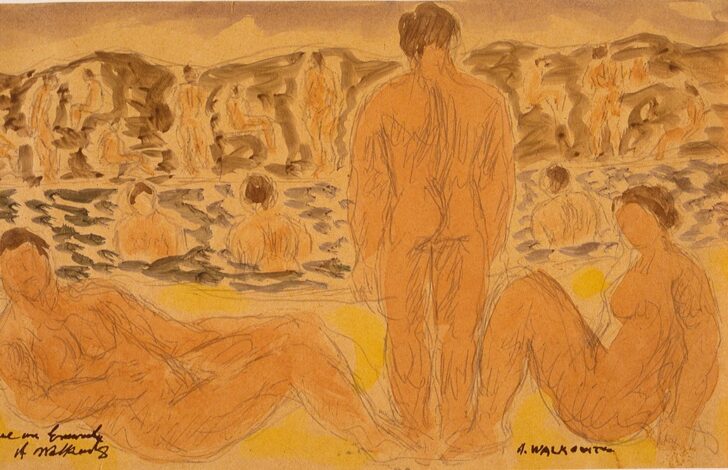Bathers
Abraham Walkowitz

Description
Born in Siberia, Abraham Walkowitz emigrated with his family to the United States when he was still a child. He is perhaps best known for his stunning series of watercolors of dancer Isadore Duncan. Walkowitz first met Duncan in the studio of Auguste Rodin in Paris in 1906. Thus began a long-term infatuation with the dancer, and his representations of her are many, each capturing the vitality and energy of her dances. In addition to Rodin, Walkowitz met many artists during his stay in Paris: Max Weber, Walter Pach, and Gertrude Stein, through whom he met Henri Matisse and Pablo Picasso.
In Bathers, Walkowitz’s style of flattening the figures and using expressive, calligraphic line is readily apparent. With broad washes of colors, Walkowitz seems to be evoking the work of Paul Cézanne, in whose work one can find similar treatment of color and flattening of composition. The loose, agitated line, however, looks back to Rodin rather than Cézanne. Still, he departs from each of his sources, creating something new and innovative in his watercolors.
"Try to develop yourself in your own way," Walkowitz advised his fellow artists in 1958. "Don’t imitate anybody. Look at pictures and forget about them. And bring your own self out. Don’t be in a hurry to exhibit. Art existed before exhibitions."
Sean M. Ulmer, University Curator of Modern and Contemporary Art, for "A Matter of Degree: Abstraction in Twentieth-Century Art," November 10, 2001 - January 27, 2002
After training in New York City at the Cooper Union, the National Academy of Design, the Art Students League, and the Educational Alliance, Walkowitz launched his career as a painter of city life and nature. Considering New York a cultural backwater, he sought artistic stimulation in Europe, journeying to England, Holland, France, and Italy from 1906–07. In Paris he enrolled in the Académie Julian, where he met fellow American artist Max Weber, who introduced him to the work of Matisse, Picasso, Rodin, and Rousseau. Both Walkowitz and Weber were also profoundly impressed by works in the memorial exhibition for Cézanne at the Salon d’Automne of 1906.
This quick watercolor sketch reflects Walkowitz’s enthusiasm for the bathers of Cézanne and Matisse. Walkowitz learned from Cézanne’s example to leave some areas of his composition blank, allowing the paper itself to suggest light and atmosphere as well as to call attention to the flat surface as an essential part of the image.
Haldeman-Julius (1889-1951) was Walkowitz's principal patron during his lifetime and knew the artist in New York during the early part of his career. Haldeman-Julius was the maternal uncle of Marvin Eisenberg.
Usage Rights:
If you are interested in using an image for a publication, please visit https://umma.umich.edu/request-image/ for more information and to fill out the online Image Rights and Reproductions Request Form.